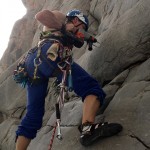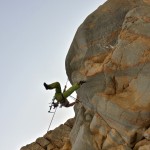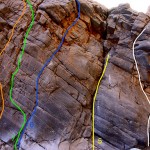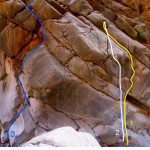
Climbing and Oman is for most, an unlikely combination. However, climbing in Oman has a relatively long history. French climbing pioneers explored the country in the 1980s and ’90s. Meanwhile, there are even some relatively well-placed sport climbing areas (mainly concentrated in the Hajar Mountains inland, between one and three hours from Muscat). Particularly attractive are the long alpine routes, which require a good deal of initiative in finding routes. An example of this is reflected in the French Pillar on Jebal Misht, a 1,100-meter long alpine route, grade 7 UIAA.
To gain a first impression of climbing in Oman, we look to Wadi Al Mayh not far from Muscat, located Scorpion Buttress, a spot with shorter, mostly crack and chimney climbing and sufficient anchorage placements. Routes here fall under grades 5+ to 7 + / 8 UIAA with up to five pitches.
Wadi Daykah – THE sports climbing spot

Further along the coast, towards Sur is Wadi Daykah a relatively large sport climbing area with clear placements and climbing difficulties graded between 6 and 8 UIAA. To the south in Wadi Tiwi good opportunities for climbing trad routes still exist. Key data with grades of 4 to 8+ UIAA and climbing passages between 100 and 500 meters characterize the Wadi. It can quickly become very hot, but for cooling off in between or for relaxing at the end of the day, extensive, crystal clear water pools in Wadi Tiwi, Wadi Shab, Wadi Bani Khalid, Bimmah Sinkhole at Fins or a dip in the ocean are all on hand.
Climbing in the Hajar Mountains
Back inland of Oman, in the Hajar mountains – is a climbing area with the most diverse range of altitude. A gigantic backdrop is provided by the Wadi Mistal – strongly reminiscent of formations of the Dolomite mountains. Here we embark on a spectacular trip to Hadash. With the assistance of a 4-wheel drive, we quickly elevate to 1,500 meters above sea level to enable us to climb the most stunning of boulders. Hadash offers good placements and sophisticated routes for climbing. The main emphasis is on grades from 7 and 10+ UIAA.
Sharaf al Almayn – views without an end

Our next climbing destination in Oman is located about an hour south through the Hajar Mountains in the direction of Nizwa. Here we make a short stop at Sharaf al Almayn-climbing area and enjoy the breathtaking panoramic views. Sharaf al Almayn located at almost 2,000 meters, offers robust, secure climbing at grades between 5 and 9 + UIAA. This is the highest sport climbing area in the country and is particularly suited to climbing in the summer months due to the rather cool climate at this altitude. Unfortunately, we haven’t had enough time to stay longer.
Moving on, Jebal Shams awaits us – the Sultanate’s highest mountain with an elevation of 3,009 meters, it is also called “Grand Canyon of Oman”. There we opt for a multi-pitch route at Nawras which leads out of the Canyon. After abseiling, the upward climb is on a somewhat eroded rock but relatively good. The climbing difficulty at this stage is mainly graded 7 + / 8 UIAA. Jebal Shams rewards the climb with breathtaking views and certain mental challenges. Overall, the placements are good, but these should be supported by mobile belaying equipment – hooks are not commonplace and are rarely found.
Climbing in Oman: The north side of the Hajar Mountains, Kubrah Canyon

The journey continues, back to the north side of the Hajar Mountains. Here is the relatively easily accessible Kubrah Canyon, a sport climbing area with its own flair. Besides Trad routes, well-placed anchor sites with climbing routes in difficulty grades 6 to 8 UIAA. can be found. We spend about one week – to climb and above all to open up a completely new sector. The objective is here to open up a climbing area, that lies in the shade during the day (from 11 am until 4 pm). The routes were successful, with a total of eight new routes drilled that consistently lie at 12.00 pm in the shade! Thanks go to the company Bergzeit that has helped us out with plenty of bolts. With these, we were able to attach stainless steel pitons in our Steep Paradise sector. Likewise, thanks to BTI for providing us with the Cordless Hammer Drill. (for those interested: BTI model A18 BH).
The Kubrah Canyon is within relatively easy reach (one hour drive), of Muscat is achievable even without a 4 wheel drive vehicle, has a pleasant approach, a car park and a wide range of various levels of grade difficulty and routes. Technically everything is well-drilled galvanized bolts should however still be looked at once prior to putting weight on them. A special treat at the Kubrah Canyon not far from the location near Nakhl (nearest larger town to the west) is the hot springs under palm trees (even at night with starry sky), where guests can relax after a hard day of climbing. On the way back a short stop at “Good Food” can be included – great value for money!
Climbing in Oman: tips, tricks and useful information for a climbing trip to the Sultanate

The Sultanate of Oman with its approximately 2.7 million inhabitants, is a land of contrasts: from modern cities to mountain villages without electricity can be found in this diverse landscape. We have certainly been drawn into the spell of this wild mountainous inland. Flying to the capital, Muscat with Oman Air, it’s then a bus, taxi, or (preferably) a four-wheel-drive vehicle on the three-lane highway that quickly turns into a gravel road.
Geographically, the country is located to the east of the Arabian peninsula, bordered in the north-west by the United Arab Emirates. Saudi Arabia is to the west of Oman and south-west is Yemen. For first ascents and new routes, there is still ample potential, divided throughout the country.
-
![The climbing areas in Oman Jabal Shams in the west up to the crag Wadi Tiwi in the east along the coast. | Compiled by]()
The climbing areas in Oman Jabal Shams in the west up to the crag Wadi Tiwi in the east along the coast. | Compiled by Temperatures: in winter between -5 ° C at night and 30 ° C during the day, in the summer to 60 ° C.
- Rainy days in Oman: Nine days of rain per year, so in winter a paradise for rock climbing.
- Arrival: Oman Air, bus, taxi, 4 wheel drive
- Lodgings: Camping in a tent
- Meals: Restaurants and co. in sufficient numbers and low budget
- Equipment: Packing list for alpine climbing
- Climbing guide Oman: Oman climbing guide by Jakob Oberhauser
More exotic reads in the Bergzeit Journal:
- Climbing Down Under Ortovox head to Tasmania
- Ski touring on Pik Lenin in Kyrgyzstan
- A trip to Lofoten in Norway to see the Aurora Borealis




